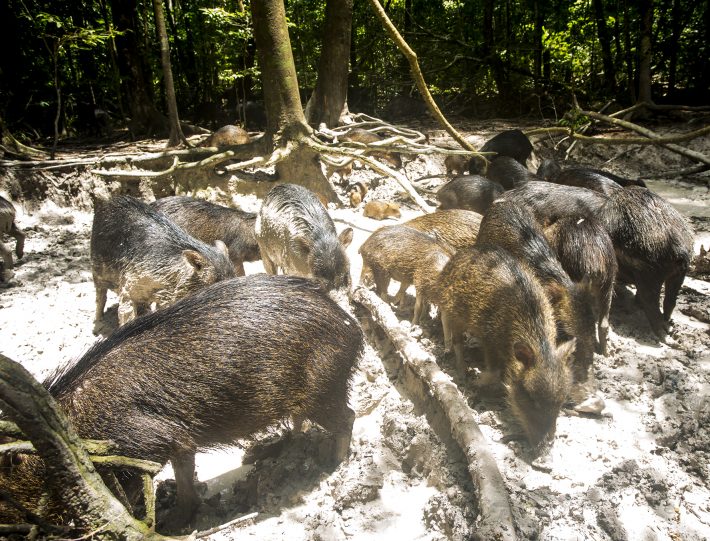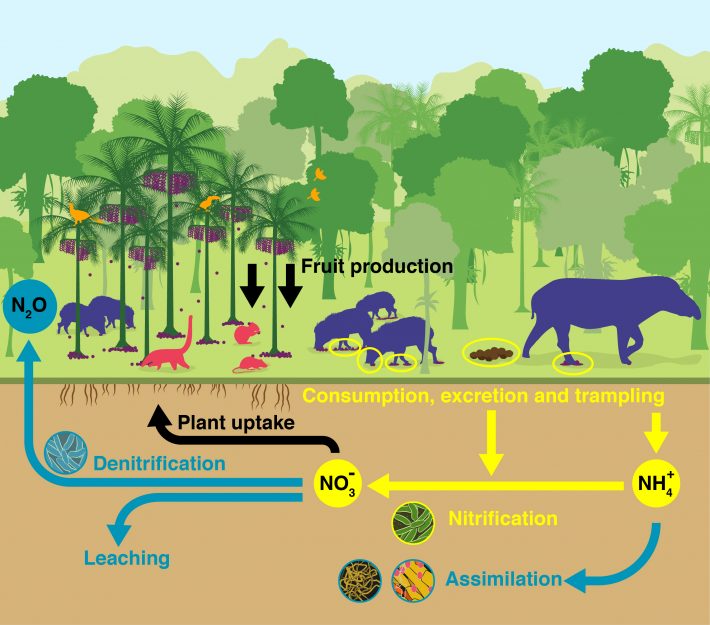Large mammals make soil more fertile in tropical forests
Agência FAPESP press release.
Research published in Functional Ecology reveals the importance of large frugivores like peccaries and tapirs to the nitrogen cycle in Brazil’s Atlantic Rainforest.

The White-lipped peccary Tayassu pecari is a boar-like hoofed mammal found throughout Central and South America. These animals roam the forest in bands of 50 to 100 individuals, eating a wide variety of foods. In Brazil’s Atlantic Rainforest, they prefer the fruit of the jussara palm Euterpe edulis.
The jussara is very abundant in this biome, probably thanks to vast amounts of dung, urine, and soil trampling by peccaries as well as tapirs (Tapirus terrestris) and other fruit-eating animals, or frugivores. This behavior releases forms of nitrogen, a key element in plant growth.
A study supported by FAPESP and published in the journal Functional Ecology showed that in areas free of these frugivores the level of ammonium, a form of nitrogen in soil, was up to 95% lower. The findings evidence for the first time the importance of these animals to the nitrogen cycle and serve as yet another warning of the ecosystem losses caused when large mammals disappear from tropical forests.
“Any farmer knows how crucial the nitrogen cycle is to achieve high crop yields. Studies in other environments have already shown that the presence of ruminants stimulates the growth of grasses thanks to the effect of their excretions on the nitrogen cycle, including optimization of microorganism activity. Our latest study has now shown that large fruit-eating mammals provide the same service in tropical forests,” said Nacho Villar, first author of the article. Villar is a researcher affiliated with São Paulo State University’s Institute of Biosciences (IB-UNESP) in Rio Claro, Brazil. Currently he is a postdoctoral fellow at the Netherlands Institute of Ecology (NIOO-KNAW).

The study also shows that these animals redistribute nitrogen, fertilizing areas that would otherwise be nutrient-poor, and hence sustain plant growth. According to the researchers’ estimates, such areas receive four times more ammonium and 50 times more nitrate than areas without frugivores.
The study was part of the Thematic Project “Ecological consequences of defaunation in the Atlantic Rainforest”, for which the principal investigator was Mauro Galetti, a professor at IB-UNESP, and was conducted under the auspices of FAPESP’s Research Program on Biodiversity Characterization, Conservation, Restoration and Sustainable Use (BIOTA-FAPESP).
The researchers used South America’s leading herbivore exclosure experiment, comprising 86 forest plots measuring 15 square meters in Serra do Mar State Park (São Paulo State), Brazil’s largest continuous Atlantic Rainforest reserve. Half the plots have been fenced since 2010 to prevent the entry of large mammals. All animals can roam freely into and out of the other plots.
Camera traps on fenced and open plots demonstrated the presence or absence of White-lipped peccaries, Collared peccaries (Pecari tajacu) and tapirs, among other frugivores.
Microorganisms, ammonium and nitrate
In this study, the researchers analyzed soil samples from eight exclusion plots and their paired open controls, collected in the wet and dry seasons. Jussara palm abundance varied across the different plots.
In soil from open plots, ammonium levels were 95% higher, and rates of nitrification (conversion of ammonium to nitrate) were also higher owing to the frugivore-driven abundance of microorganisms in the soil. Although plants absorb ammonium, their metabolism can immediately use nitrate, which is therefore considered more valuable in terms of plant growth.
“Peccaries account for 80% to 90% of the total mammal biomass in the Atlantic Rainforest. Large groups of these animals roam extensive territories, fertilizing the forest,” Villar said. “Tapir density is lower, so their contribution to the nitrogen cycle isn’t as great, but the amount excreted by each individual is considerable, as is each animal’s range as it disperses seeds.” Another study by the same group had already shown how peccaries and tapirs contribute to plant species diversity and abundance (read more at: https://agencia.fapesp.br/31840).
This large frugivore biomass is attracted by the vast amount of fruit from jussara palms, whose abundance is due to fertilization of the soil by the animals’ excretions (which also probably increase the palms’ fruit-bearing capacity). The outcome is a virtuous cycle for animals, plants and soil microorganisms (also stimulated by the excretions), leading the researchers to propose the term “fruiting lawns” as a description of such areas. The term is considered analogous to the concept of grazing lawns, which refers to the positive feedback between ruminant food consumption and food availability in African savannas and other grassland landscapes.
The next steps in the group’s research will include investigating whether the increase in nitrogen due to plants’ interaction with large mammals boosts their carbon absorption and reduces the release of greenhouse gases from the soil. If so, plant-animal interaction should play a major role in regulating global climate change.
The article “Frugivory underpins the nitrogen cycle” by Nacho Villar, Claudia Paz, Valesca Zipparro, Sergio Nazareth, Leticia Bulascoschi, Elisabeth S. Bakker and Mauro Galetti can be read at: https://besjournals.onlinelibrary.wiley.com/doi/10.1111/1365-2435.13707.
This text was originally published by FAPESP Agency according to Creative Commons license CC-BY-NC-ND. Read the original here.
Like what we stand for?
Support our mission and help develop the next generation of ecologists by donating to the British Ecological Society.